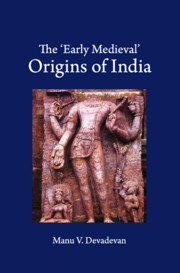Book contents
- Frontmatter
- Dedication
- Contents
- List of Tables
- List of Maps and Figures
- Acknowledgements
- 1 Introduction
- I INSTITUTIONS
- 2 State Formation and Its Structural Foundations
- 3 From the Cult of Chivalry to the Cult of Personality: The Seventh- Century Transformation in Pallava Statecraft
- 4 Changes in Land Relations and the Changing Fortunes of the Cēra State
- 5 Temple and Territory in the Puri Jagannātha Imaginaire
- II IDEAS
- 6 Svayaṃbuddha's Predilections: The Epistemologies of Time and Knowledge
- 7 Bhāravi and the Creation of a Literary Paradigm
- 8 Knowing and Being: The Semantic Universe of the Kūḍiyāṭṭaṃ Theatre
- 9 The Invention of Zero and Its Intellectual Legacy
- III IDENTITIES
- 10 The Evolution of Vernacular Languages: A Case Study of Kannada
- 11 Religious Identities in Times of Indumauḷi's Grief
- 12 Caste, Gender, and the Landed Patriarchy
- 13 The Making of Territorial Self Consciousness (with Particular Reference to Kaliṅga)
- Bibliography
- Index
5 - Temple and Territory in the Puri Jagannātha Imaginaire
Published online by Cambridge University Press: 02 May 2020
- Frontmatter
- Dedication
- Contents
- List of Tables
- List of Maps and Figures
- Acknowledgements
- 1 Introduction
- I INSTITUTIONS
- 2 State Formation and Its Structural Foundations
- 3 From the Cult of Chivalry to the Cult of Personality: The Seventh- Century Transformation in Pallava Statecraft
- 4 Changes in Land Relations and the Changing Fortunes of the Cēra State
- 5 Temple and Territory in the Puri Jagannātha Imaginaire
- II IDEAS
- 6 Svayaṃbuddha's Predilections: The Epistemologies of Time and Knowledge
- 7 Bhāravi and the Creation of a Literary Paradigm
- 8 Knowing and Being: The Semantic Universe of the Kūḍiyāṭṭaṃ Theatre
- 9 The Invention of Zero and Its Intellectual Legacy
- III IDENTITIES
- 10 The Evolution of Vernacular Languages: A Case Study of Kannada
- 11 Religious Identities in Times of Indumauḷi's Grief
- 12 Caste, Gender, and the Landed Patriarchy
- 13 The Making of Territorial Self Consciousness (with Particular Reference to Kaliṅga)
- Bibliography
- Index
Summary
Land occupied an important place—perhaps the central place, so to speak—in our discussions in Chapters 2, 3, and 4. And another important presence in these discussions was of the temple. The eleemosynary grants of land, which the temple received in great numbers, made it a formidable institution in terms of the power and influence it could wield. Between the seventh and the twelfth centuries, the temple–land nexus found a compelling reified expression in the form of the making of sacred geographies, a process that expanded exponentially between the thirteenth and the eighteenth centuries.
The articulation of sacred geographies borrowed extensively from narratives of legends from the past. The past was in fact the preeminent referent in relation to which the sacredness of places, localities, and regions were imagined. Already in the sixth or the seventh century, Kashmir had produced a text on the sacredness of its geography, the Nīlamatapurāṇa. The image and identity of Kashmir that Kalhaṇa drew in his Rājataraṅgiṇī is an expansion of the course set into motion in the Nīlamatapurāṇa. In a stroke of poetic brilliance, Kalhaṇa produced a text in which legacies from the past were firmly set against the rich Himalayan geography of Kashmir to produce the picture of a region that was as much the product of human volition as it was of the bounties of nature. The political content in the Rājataraṅgiṇī's definition of the region had its counterpart from the other end of the subcontinent in the sixteenth-century Kēraḷōlpatti tradition of Kerala, where the description of the region occurred in the form of an ethnographic-looking account of the evolution of the region, where every development was understood as the result of conscious and regular political interventions across the centuries.
The appeal to the past in the description of human geography was a practice that seems to have had its origin in the Purāṇas. Given their religious preferences and near-total disdain for royal dynasties of the Kaliyuga, the Purāṇas gave accounts of religious centres—mostly tīrthas and temple towns—in which the making of sacred geographies was understood in terms of divine interventions in a mythic past. This was a masterly redefinition of the territory that was hard, if not altogether impossible, for contemporary ruling dynasties to appropriate.
- Type
- Chapter
- Information
- The ‘Early Medieval' Origins of India , pp. 151 - 182Publisher: Cambridge University PressPrint publication year: 2020



